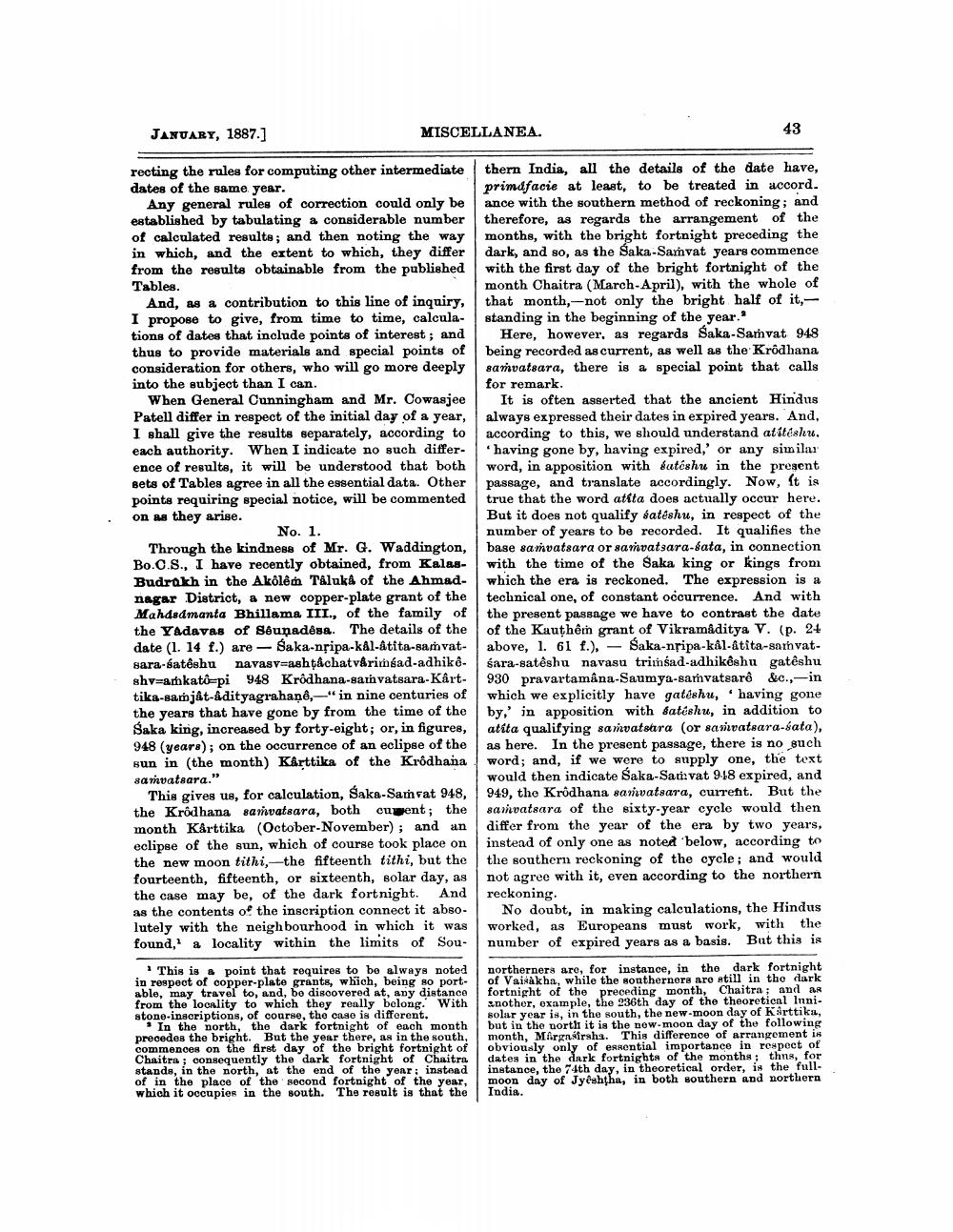________________
MISCELLANEA.
JANUARY, 1887.]
recting the rules for computing other intermediate dates of the same year.
Any general rules of correction could only be established by tabulating a considerable number of calculated results; and then noting the way in which, and the extent to which, they differ from the results obtainable from the published Tables.
And, as a contribution to this line of inquiry, I propose to give, from time to time, calculations of dates that include points of interest; and thus to provide materials and special points of consideration for others, who will go more deeply into the subject than I can.
When General Cunningham and Mr. Cowasjee Patell differ in respect of the initial day of a year, I shall give the results separately, according to each authority. When I indicate no such difference of results, it will be understood that both sets of Tables agree in all the essential data. Other points requiring special notice, will be commented on as they arise.
No. 1.
Through the kindness of Mr. G. Waddington, Bo.C.S., I have recently obtained, from KalasBudrakh in the Akôlêm Taluk of the Ahmadnagar District, a new copper-plate grant of the Mahdsdmanta Bhillama III., of the family of the Yadavas of Sêunadêsa. The details of the date (1. 14 f.) are - Saka-nṛipa-kâl-âtita-samvatsara-satêshu navasv-ashtachatvâriméad-adhikêshv-amkato-pi 948 Krôdhana-samvatsara-Kârttika-samjât-adityagrahanê, "in nine centuries of the years that have gone by from the time of the Šaka king, increased by forty-eight; or, in figures, 948 (years); on the occurrence of an eclipse of the sun in (the month) Kârttika of the Krodhana samvatsara."
This gives us, for calculation, Saka-Samvat 948, the Krodhana samvatsara, both cument; the month Kârttika (October-November); and an eclipse of the sun, which of course took place on the new moon tithi,-the fifteenth tithi, but the fourteenth, fifteenth, or sixteenth, solar day, as the case may be, of the dark fortnight. And as the contents of the inscription connect it absolutely with the neighbourhood in which it was found, a locality within the limits of Sou
This is a point that requires to be always noted in respect of copper-plate grants, which, being so portable, may travel to, and, be discovered at, any distance. from the locality to which they really belong. With stone-inscriptions, of course, the case is different.
In the north, the dark fortnight of each month precedes the bright. But the year there, as in the south, commences on the first day of the bright fortnight of Chaitra; consequently the dark fortnight of Chaitra stands, in the north, at the end of the year: instead of in the place of the second fortnight of the year, which it occupies in the south. The result is that the
43
thern India, all the details of the date have, primafacie at least, to be treated in accord. ance with the southern method of reckoning; and therefore, as regards the arrangement of the months, with the bright fortnight preceding the dark, and so, as the Saka-Samvat years commence with the first day of the bright fortnight of the month Chaitra (March-April), with the whole of that month,-not only the bright half of it,standing in the beginning of the year."
Here, however, as regards Saka-Samvat 948 being recorded as current, as well as the Krodhana samvatsara, there is a special point that calls for remark.
It is often asserted that the ancient Hindus always expressed their dates in expired years. And, according to this, we should understand atitéshu. 'having gone by, having expired,' or any similar word, in apposition with satéshu in the present passage, and translate accordingly. Now, it is true that the word atita does actually occur here. But it does not qualify satéshu, in respect of the number of years to be recorded. It qualifies the base samvatsara or samvatsara-sata, in connection with the time of the Saka king or kings from which the era is reckoned. The expression is a technical one, of constant occurrence. And with the present passage we have to contrast the date of the Kauthêm grant of Vikramåâditya V. (p. 24 above, 1. 61 f.), Saka-nripa-kâl-âtita-samvatsara-satêshu navasu trimsad-adhikêshu gatêshu 930 pravartamâna-Saumya-samvatsarê &c.,-in which we explicitly have gatéshu, having gone by,' in apposition with satéshu, in addition to atita qualifying samvatsara (or samvatsara-sata), as here. In the present passage, there is no such word; and, if we were to supply one, the text would then indicate Saka-Samvat 918 expired, and 949, the Krodhana samvatsara, current. But the samvatsara of the sixty-year cycle would then differ from the year of the era by two years, instead of only one as noted below, according to the southern reckoning of the cycle; and would not agree with it, even according to the northern reckoning.
No doubt, in making calculations, the Hindus worked, as Europeans must work, with the number of expired years as a basis. But this is
northerners are, for instance, in the dark fortnight of Vaisakha, while the southerners are still in the dark fortnight of the preceding month, Chaitra; and as another, example, the 236th day of the theoretical lunisolar year is, in the south, the new-moon day of Karttika, but in the north it is the new-moon day of the following month, Margasirsha. This difference of arrangement is obviously only of essential importance in respect of dates in the dark fortnights of the months; thus, for instance, the 74th day, in theoretical order, is the fullmoon day of Jyeshtha, in both southern and northern India.




